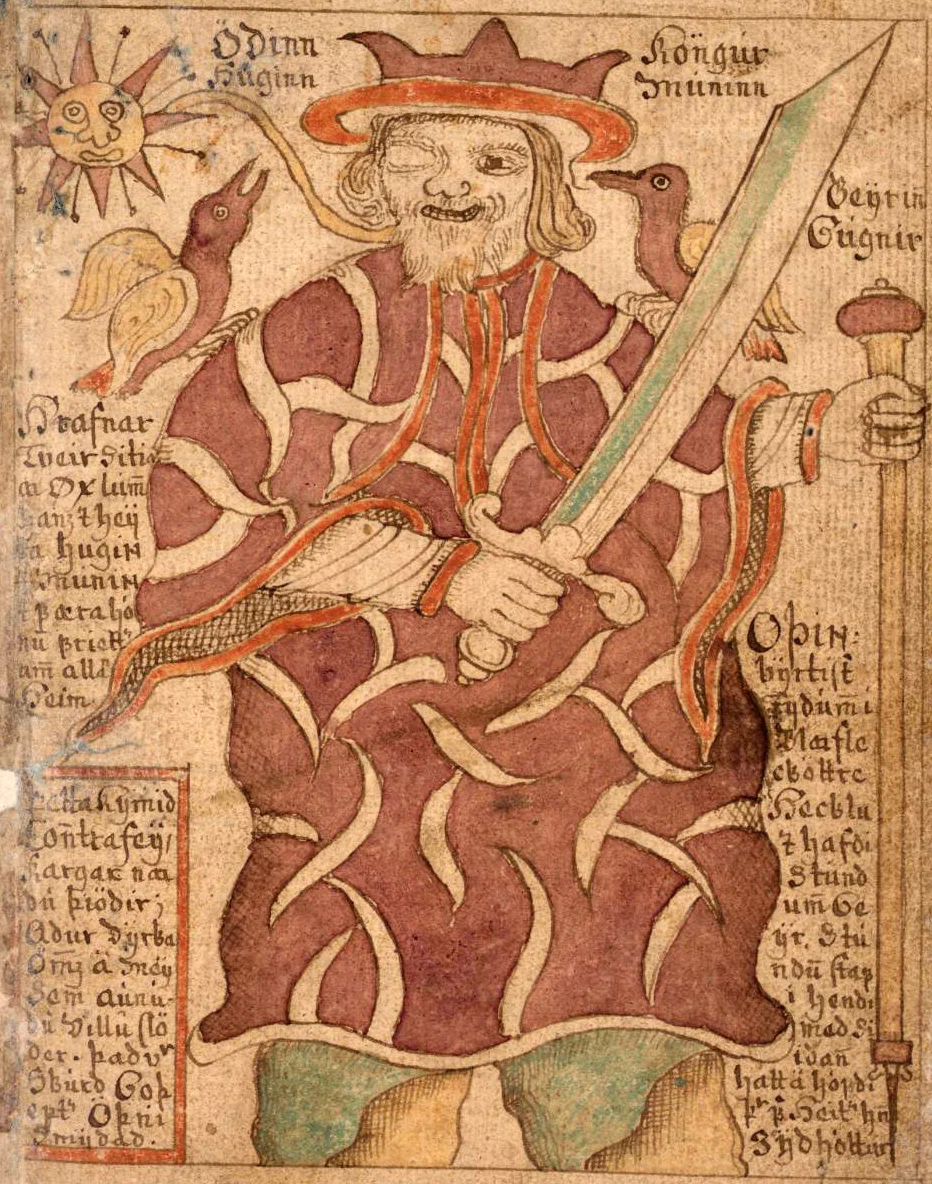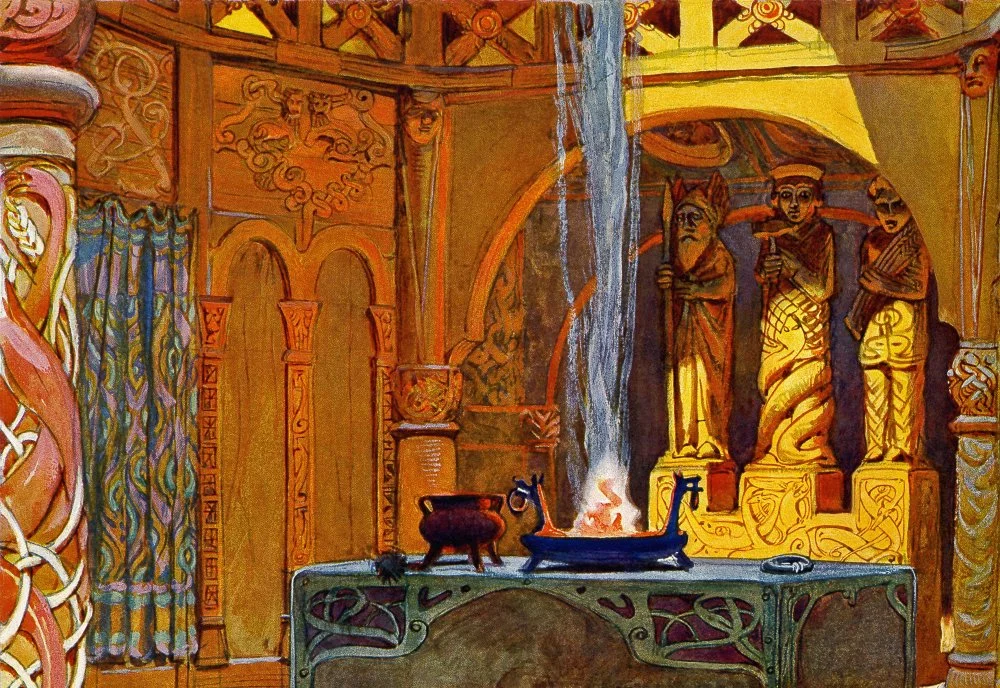Dangling From a Tree
You Really Don’t Want to Know About How Christmas Trees Should be Decorated

As the Flames Rise, Wotan Leaves, 1906. /Alamy
It's a dreadful time when the sun seems eager to bid farewell to the sky for good. The world is entangled in ice, and the frigid embrace of death reigns over the snowy expanse. Beasts seek refuge in their burrows, and people in their squat huts or dugouts are thoroughly blanketed by snow drifts. Folks gather by smoky hearths, huddling together, gnawing on dried meat, and softening peas with thawed water. The day keeps shrinking, and the sun, too, decides to venture towards its demise, appearing in the sky only as a faint shadow for a few hours – darkness looms, ushering in an intense cold.
Thankfully, since ancient times, our forebears enlightened us regarding how to appease the sun and beseech its return to the sky. The last days approach but do not actually arrive, for there will be a Great Sacrifice.
We have scant knowledge of the truly ancient rituals of the European North, but we're considerably more informed about what they transformed into over time. Mass human sacrifices occurring during the winter solstice among the Germanic and Scandinavian peoples are vividly described in numerous sources. The European chronicler of the 10th-11th centuries, Bishop Thietmar of Merseburg, not prone to tendentiousness and inaccuracies, nonchalantly mentions that in Zealand,i
In the sanctuary of Swedish Uppsala,i


If we delve five hundred years deeper into the past, Tacitus' "Germania"i

Ferdinand Leeke. Wotan and Brünnhilde, 1930/Alamy
The origin of cults in their infancy remains speculative, reconstructed not from written evidence, which did not exist then, but from their echoes in subsequent eras.
Wotan, or Odin, was the supreme deity of Germanic-Scandinavian mythology. In his mature form, the god represents the head of the pantheon, a one-eyed warrior and poet, a sorcerer, and a sage. The central myth about Odin is a tale of him gaining powerful knowledge and transforming himself into the Allfather, the head of all other gods and spirits. Odin acquired his power by hanging himself on the World Tree and piercing himself with a spear. After hanging on the tree for nine or twelve days, he ultimately resurrects as an immensely powerful being. The very name of the World Tree – Yggdrasil – can be translated as "Odin's Gallows" ("Ygg," "awful," one of the sacred names of this god; "drasil" -steed, often used as a tabooed term for the gallows – "gallow steed").
Frazer, who devoted his life specifically to studying the history of myth, draws a logical conclusion that Wotan, by origin, is one of the "sacrificial gods" that, during Frazer's time, could still be observed in action among some peoples and tribes in the civilized stage of the Stone Age. A human becomes a sacrificial god, brought in as a sacrifice (often in an extremely harsh manner), after which parts of their body – bones, skull, skin – become objects of worship. (And the meat is often used for ritualistic cannibalism). A person typically chosen for sacrifice is an aging king, a royal son, or a mighty warrior selected through a special “draw.”
Wotan aligns well with the scheme of a sacrificial god on the calendar. Selected by fate (perhaps with a baked bean in the portion of ritual bread assigned to him), a warrior with a gouged-out eye, hanging in a sacred grove on a revered tree, pierced with a spear, transforms into a mighty defender of his people. His spirit would return to the earth, and the sun would turn as red as his blood on the snow, his missing eye keenly watching over enemies while his bones, clattering in the wind, ward off evil from the people. Another name for Odin, Yule-Being, indicates that he is indeed the sacrificial spirit of the Winter Solstice. The days in the middle of winter when the sun was ready to bid farewell to the world were called "yule," further affirming Odin's identity.

Koloman Moser. Wotan and Bronhilde. Leopold Museum, Vienna/Alamy
So, we can guess what we’re supposed to decorate our Christmas trees with, and it’s not shiny glass ornaments or candy canes.
By the way, the myth of Odin greatly assisted Christian missionaries who sought to convert the pagans of northern Europe. A god hanging on something wooden and pierced by a spear? A remarkably fitting coincidence. And to subjugate the indomitable tradition of Yule rituals, the legend that Jesus was born precisely during the days of the Winter Solstice proved useful (which is highly unlikely, even during the ancient climatic optimumi
And thus, the terrifying winter sacrifice holiday ultimately transformed into the joyous Christmas.

In the Temple at Uppsala, an ancient Norse religious site in Sweden, housed statues of Thor, Wotan, and Frey/Alamy
References
1. Gurevich, A. Y. Selected Works. In 4 volumes. Moscow-St. Petersburg, 1999.
2. Dryakhlov, V. In the Sacred Groves of Wotan. Kirov, 2002.



